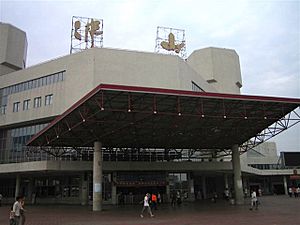Foshan facts for kids
Quick facts for kids
Foshan
佛山市
Fatshan
|
|
|---|---|
|
Prefecture-level city
|
|
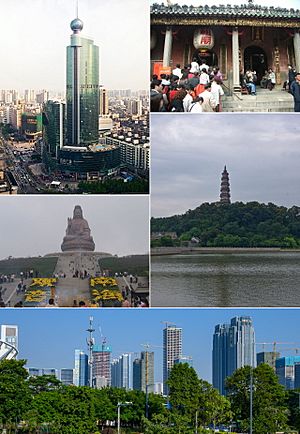
Clockwise from top right: Zumiao of Foshan, Qingyun Tower in Shunfengshan Park, Foshan New Town in Shunde, Guanyin atop Mount Xiqiao, & Downtown Foshan in Chancheng
|
|
| Nickname(s):
禅 (Chan)
|
|
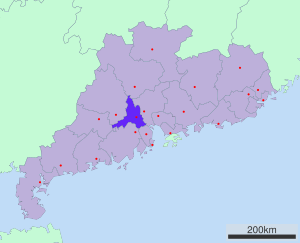
Location of Foshan in Guangdong
|
|
| Country | |
| Province | Guangdong |
| Municipal seat | Chancheng District |
| Area | |
| • Prefecture-level city | 3,848 km2 (1,486 sq mi) |
| • Water | 690 km2 (270 sq mi) |
| • Urban | 3,848 km2 (1,486 sq mi) |
| • Metro | 19,870.4 km2 (7,672.0 sq mi) |
| Elevation | 16 m (52 ft) |
| Population
(2020 census)
|
|
| • Prefecture-level city | 9,498,863 |
| • Density | 2,468.5/km2 (6,393.4/sq mi) |
| • Urban | 26,940,000 |
| • Urban density | 7,001.0/km2 (18,133/sq mi) |
| • Metro | 65,594,622 |
| • Metro density | 3,301.122/km2 (8,549.868/sq mi) |
| GDP | |
| • Prefecture-level city | CN¥ 1.759 trillion US$ 166.8 billion |
| • Per capita | CN¥ 127,085 US$ 19,699 |
| Time zone | UTC+8 (China Standard Time) |
| Postal code |
528000
|
| Area code(s) | (0)757 |
| ISO 3166 code | CN-GD-06 |
| Licence plate prefixes |
|
| Foshan | |||||||||||||||||||||||||||||
|---|---|---|---|---|---|---|---|---|---|---|---|---|---|---|---|---|---|---|---|---|---|---|---|---|---|---|---|---|---|

"Foshan" in Chinese characters
|
|||||||||||||||||||||||||||||
| Chinese | 佛山 | ||||||||||||||||||||||||||||
| Hanyu Pinyin | Fóshān | ||||||||||||||||||||||||||||
| Cantonese Yale | Fahtsàan or Fahtsāan | ||||||||||||||||||||||||||||
| Postal | Fatshan | ||||||||||||||||||||||||||||
| Literal meaning | "Buddha Mountain" | ||||||||||||||||||||||||||||
|
|||||||||||||||||||||||||||||
Foshan is a big city in central Guangdong Province, China. It's known as a "prefecture-level city," which means it's a major city that also manages several smaller areas around it. The whole area of Foshan is about 3,848 square kilometers.
In 2020, nearly 9.5 million people lived in Foshan. The city is part of a huge urban area called the Pearl River Delta Economic Zone. This area is home to over 65 million people, making it one of the largest urban areas in the world!
Foshan is famous for its culture. It's seen as the birthplace of Cantonese opera, which is a type of Chinese musical theater. It's also known for Nanquan, a powerful martial art, and for lively lion dancing.
Contents
- What's in a Name?
- A Look Back in Time: Foshan's History
- Where is Foshan?
- Foshan's Economy
- How Foshan is Organized
- Languages Spoken in Foshan
- Getting Around Foshan
- Learning in Foshan
- Sports in Foshan
- Fun Places to Visit in Foshan
- Foshan's Sister Cities
- Famous People from Foshan
- Images for kids
- See also
What's in a Name?
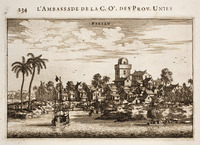
The name Fóshān comes from the Chinese words 佛山. In Mandarin Chinese, it means "Buddha Mountain." You might also see it spelled "Fatshan," which comes from how people say it in Cantonese.
The name "Buddha Mountain" refers to a small hill near the city center. Back in the year 628 AD, three bronze statues of Buddha were found there. A monastery (a place where monks live) was built nearby, and the town grew up around it. Even though the monastery was destroyed in 1391, the name stuck!
A Look Back in Time: Foshan's History
Early Days and Growth
For a long time, Foshan was a small town along the Fen River. It started growing around a Buddhist monastery built during the Tang dynasty. When that monastery was destroyed in 1391, the Foshan Ancestral Temple, a Taoist temple dedicated to the Northern God, became the new heart of the community. This temple was rebuilt in 1372 and is still an important place today.
By the early Ming Dynasty, Foshan became one of China's four biggest markets. It was especially famous for its beautiful ceramics (pottery) and metalwork. During the Qing Dynasty, Foshan was even called the "Birmingham of China" because of its strong steel industry.
Foshan in the 20th Century
In the early 1900s, Foshan got railway connections to nearby cities like Guangzhou. After the Chinese Civil War ended in 1949, the Ancestral Temple became the Foshan Municipal Museum.
Foshan continued to be a major center for ceramics and steel. In 1951, it became its own city, separate from Nanhai County. By the 1970s, Foshan had grown to 300,000 people, making it the second-largest city in Guangdong Province after Guangzhou.
Later, in 1983, Foshan became a "prefecture-level city," which meant it became even more important. In 2002, the areas of Shunde and Nanhai officially joined Foshan's main urban area.
Recently, a special Japanese-themed street called Ichiban Street opened in Foshan. It looks just like famous shopping streets in Japan, even with a sakura (cherry blossom) tree! This street has become very popular with young people who couldn't travel abroad during the coronavirus pandemic.
Where is Foshan?
Foshan is located on the Fen River, which is part of the Pearl River Delta. This delta is a large area where rivers meet the sea. Foshan is about 25 kilometers (15 miles) southwest of Guangzhou, another major city. It's also near Zhongshan to the southeast and Jiangmen to the south.
Foshan's Climate
Foshan has a humid subtropical climate. This means it has hot, humid summers and mild, drier winters. It's a bit like the weather in places like Florida in the USA or parts of Japan.
| Climate data for Foshan (Nanhai District, 1991–2020 normals, extremes 1951–2010) | |||||||||||||
|---|---|---|---|---|---|---|---|---|---|---|---|---|---|
| Month | Jan | Feb | Mar | Apr | May | Jun | Jul | Aug | Sep | Oct | Nov | Dec | Year |
| Record high °C (°F) | 26.7 (80.1) |
27.1 (80.8) |
30.7 (87.3) |
32.7 (90.9) |
35.6 (96.1) |
37.1 (98.8) |
38.5 (101.3) |
38.5 (101.3) |
37.8 (100.0) |
34.2 (93.6) |
30.6 (87.1) |
28.8 (83.8) |
38.5 (101.3) |
| Mean daily maximum °C (°F) | 18.3 (64.9) |
19.7 (67.5) |
22.3 (72.1) |
26.7 (80.1) |
30.5 (86.9) |
32.4 (90.3) |
33.7 (92.7) |
33.6 (92.5) |
32.2 (90.0) |
29.4 (84.9) |
25.2 (77.4) |
20.4 (68.7) |
27.0 (80.7) |
| Daily mean °C (°F) | 14.0 (57.2) |
15.7 (60.3) |
18.6 (65.5) |
23.0 (73.4) |
26.6 (79.9) |
28.6 (83.5) |
29.5 (85.1) |
29.4 (84.9) |
28.1 (82.6) |
25.1 (77.2) |
20.7 (69.3) |
15.8 (60.4) |
22.9 (73.3) |
| Mean daily minimum °C (°F) | 11.1 (52.0) |
12.9 (55.2) |
15.9 (60.6) |
20.3 (68.5) |
23.7 (74.7) |
25.8 (78.4) |
26.5 (79.7) |
26.3 (79.3) |
25.0 (77.0) |
21.9 (71.4) |
17.4 (63.3) |
12.6 (54.7) |
20.0 (67.9) |
| Record low °C (°F) | −1.9 (28.6) |
2.3 (36.1) |
3.4 (38.1) |
10.5 (50.9) |
14.9 (58.8) |
18.7 (65.7) |
22.8 (73.0) |
23.3 (73.9) |
19.6 (67.3) |
10.7 (51.3) |
4.4 (39.9) |
3.1 (37.6) |
−1.9 (28.6) |
| Average precipitation mm (inches) | 53.1 (2.09) |
54.4 (2.14) |
95.8 (3.77) |
161.5 (6.36) |
260.9 (10.27) |
308.1 (12.13) |
226.6 (8.92) |
266.3 (10.48) |
211.1 (8.31) |
78.7 (3.10) |
42.2 (1.66) |
35.2 (1.39) |
1,793.9 (70.62) |
| Average precipitation days (≥ 0.1 mm) | 7.2 | 9.3 | 13.8 | 14.6 | 17.2 | 18.5 | 16.5 | 15.8 | 12.3 | 5.3 | 5.7 | 5.7 | 141.9 |
| Average relative humidity (%) | 71 | 76 | 79 | 80 | 79 | 80 | 77 | 77 | 74 | 67 | 67 | 65 | 74 |
| Mean monthly sunshine hours | 104.3 | 75.1 | 61.8 | 73.2 | 112.5 | 132.6 | 178.8 | 167.5 | 157.0 | 170.5 | 150.8 | 140.4 | 1,524.5 |
| Percent possible sunshine | 31 | 23 | 17 | 19 | 27 | 33 | 43 | 42 | 43 | 48 | 46 | 42 | 35 |
| Source: China Meteorological Administrationall-time extreme temperature | |||||||||||||
Foshan's Economy
Foshan has a strong economy. It has been famous for its ceramics (pottery) since the Ming dynasty.
In 2015, Foshan's total economic output was about 0.8 trillion Chinese Yuan. This means the average income per person was over $10,000 US dollars. One part of Foshan, Shunde District, is especially rich. It has over 3,000 factories that make electronic appliances. These factories produce more than half of the world's air conditioners and refrigerators!
Foshan also has more than 30 towns that specialize in certain industries. For example, some towns focus on making furniture, others on machinery, and some on beverages. There's also a Foshan Hi-Tech Development Zone, which is a special area for new technology and industries like car assembly and biotechnology.
How Foshan is Organized
Foshan is a "prefecture-level city" that manages five smaller areas called districts. These districts are:
- Chancheng
- Nanhai
- Sanshui
- Gaoming
- Shunde
These districts are further divided into smaller parts like subdistricts and towns. Foshan is very connected to Guangzhou and is an important part of the larger Guangdong-Hong Kong-Macau Greater Bay Area.
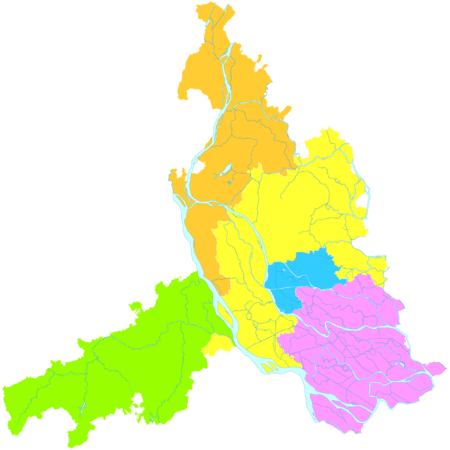
Chancheng
Nanhai
Shunde
Sanshui
Gaoming
|
||||||||||||||||||||||||||||||||||||||||||||||||||||||||||||||||||||||||||||||||||||||||
Languages Spoken in Foshan
Most people who grew up in Foshan speak a type of Cantonese called Samyap. However, Mandarin is also used, especially in schools and for business. While many locals understand Mandarin, they usually speak Cantonese in their daily lives.
Getting Around Foshan
Foshan has been working to make its public transportation even better.
Foshan Metro (FMetro)
The city has its own subway system called FMetro. The first line opened in 2010. More lines are being built to help people travel easily around the city.
- Line 1 (Guangfo Line): Connects Xinchengdong Station to Lijiao Station
- Line 2: Runs from Nanzhuang Station to Guangzhou South Railway Station
- Line 3: Goes from Shunde Polytechnic Station to Zhen'an Station
Trains
Foshan is an important train hub. You can catch trains here that connect to Guangzhou, Hong Kong, and other parts of western Guangdong Province. There's even a special train service that goes directly to Hong Kong from Foshan railway station.
Air Travel
Foshan has an airport called Foshan Shadi Airport. There are also plans for a new airport, the Pearl River Delta International Airport, to serve the region.
Learning in Foshan
In Foshan's public schools, the main language used for teaching is Mandarin.
Universities in Foshan
- Foshan University
- South China Normal University (Foshan campus)
- Southern Medical University (Shunde campus)
- Guangdong University of Finance & Economics (Sanshui campus)
Schools in Foshan
- Nanhai Senior High School
Sports in Foshan
Foshan is a city that loves sports!
- It was one of the host cities for the 2019 FIBA Basketball World Cup.
- During the 2010 Asian Games, Foshan hosted events like Synchronized swimming at the Foshan Aquatics Center and boxing at the Foshan Gymnasium.
- In 2014, the city hosted The Foshan Open, a professional golf event.
Foshan has also been home to professional football (soccer) teams.
Fun Places to Visit in Foshan
If you visit Foshan, here are some cool places to check out:
- Foshan Ancestral Temple (Zumiao): A beautiful and historic Taoist temple.
- Nanfeng Kiln: A very old pottery kiln that has been used for centuries.
- Liang's Garden: A peaceful and traditional Chinese garden.
- Wong Fei-hung Memorial Hall: A museum dedicated to the famous martial artist Wong Fei-hung.
Foshan's Sister Cities
Foshan has "sister city" relationships with many cities around the world. This means they share cultural and economic ties.
 Itami, Japan
Itami, Japan La Possession, France
La Possession, France Port Louis, Mauritius
Port Louis, Mauritius Oakland, California, United States
Oakland, California, United States Stockton, California, United States
Stockton, California, United States Markham, Ontario, Canada (Friendly co-operative)
Markham, Ontario, Canada (Friendly co-operative) Townsville, Australia
Townsville, Australia Medway, United Kingdom
Medway, United Kingdom Starogard Gdański, Poland
Starogard Gdański, Poland St. George's, Grenada
St. George's, Grenada Ingolstadt, Germany
Ingolstadt, Germany
Famous People from Foshan
Many notable people have come from Foshan, especially famous martial artists!
- Chan Wah-shun (c.1836–1906): A martial arts teacher.
- Ip Ching (1936-2020): A martial artist.
- Ip Chun (born 1924): A martial artist and actor, known for the Wing Chun style.
- Ip Man (1893–1972): A grandmaster of Wing Chun martial arts and a teacher of Bruce Lee.
- Kang Youwei (1858-1927): A political thinker and reformer.
- Lam Sai-wing (1861–1943): A master of Hung Gar martial arts.
- Law Kar-ying (born 1946): A famous Hong Kong Cantonese opera singer and actor.
- Lee Shau-kee (born 1928): A Hong Kong billionaire and philanthropist.
- Leung Jan (1826-1901): A Wing Chun master and doctor.
- Wong Fei Hung (1847–1925): A legendary Hung Ga martial arts master and doctor, honored at a memorial hall in Chancheng.
- Wu Yee-sun (1900-2005): A Hong Kong entrepreneur and billionaire.
- Yam Kim-fai (1912-1989): A famous Cantonese opera actress.
- Yang Huiyan (born 1981): A successful businesswoman.
- Yuen Kay-shan (1889-1956): A Grandmaster of Wing Chun.
Images for kids
See also
 In Spanish: Foshan para niños
In Spanish: Foshan para niños


